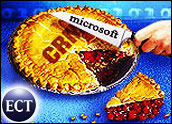
I was on vacation when the news came out and for the life of me, I could not understand why Microsoft decided to announce version 3.0 of its CRM product a few days before July 4th — the biggest public holiday of the year — when practically no one was looking. They weren’t alone. Siebel also made an announcement designed to garner minimal exposure.
When I finally got to read the Microsoft press release, I understood — they were pre-announcing by six months. The product was scheduled for release at the end of the year. Six months is a long time in our trade and it made me think of the database wars of the 1980s when vendors would routinely pre-announce new products in the hope of freezing purchase decisions. That wouldn’t be a bad strategy for the software giant since other vendors currently have better competitive positions than Redmond — the tacit acknowledgement was made by Microsoft’s early announcement and a focus on its upcoming marketing module. But there are plenty of buyers who might prefer to put all their application eggs in one basket, and for them, waiting, even six months, would be prudent.
Then there was Siebel’s announcement around the same time. According to the press release, at a London conference, Siebel and IBM announced, “Siebel Systems is now offering the Siebel 7.8 Web UI Dynamic Developer Kit (DDK), a SOA solution that leverages IBM WebSphere Application Server and IBM WebSphere Portal to allow organizations to provide access to Siebel functionality through portals and custom Web applications.”
Other vendors have been announcing similar products and strategies to enable customers to deploy semi-custom applications quickly and cost effectively. Siebel UI DDK sounds roughly similar to NetSuite’s NetFlex or Salesforce.com’s MultiForce, CustomForce, Sforce combination, but the marketing approach could not be more different. But while Siebel served up enough abbreviations and initials to sink the proverbial battleship, Salesforce held a party. Go figure.
‘Misunderestimating’ CRM’s Role
CRM has been stuck on a treadmill for some time and the announcements I have recently seen indicate that we aren’t ready to move ahead any time soon. There is still too much emphasis (in my humble opinion) on lowering the cost of deployment and too much focus on using the software to support vendor centric transactions rather than truly managing the customer relationship. You might ask why this is important. After all, today’s CRM suite covers the major areas of sales, marketing and service pretty well. What else is left?”
Well, there is quite a lot left to cover because today’s CRM suite seems designed to fight the last war. Specifically, we’re still designing CRM to support the high rate of transactions we saw in the last boom, but that may be an unrealistic assumption. CRM designed for those boom times was predicated on two assumptions that no longer hold:
- 1. The number of potential customers any vendor could anticipate is not a limiting factor;
2. The heart of the relationship is the transaction itself.
As Peppers and Rogers note in their new book Return on Customer: Creating Maximum Value from Your Scarcest Resource, “Once an economy matures, customers are no longer so hungry to buy, but businesses are even hungrier to sell.” Once everyone has a car or a cell phone or an iPod, growth becomes harder to come by and systems designed to accelerate transactions are about as useful as fins and gills in the Mojave — yet we keep making their software equivalents.
What to do? Well for starters, it might be good to acknowledge that deployment is not the massive challenge it was a few years ago. Yes, it still costs something to deploy a CRM system and train your users, but we have reached the point where we’ve reasonably wrung the last bit of excess cost out of the equation. Software, after all, is not a U.S. Treasury security that you can calculate a yield for; to get your money’s worth (e.g. ROI), you have to actually use it to accomplish something. That’s where ROI and transaction processing collide with today’s reality.
Re-Orienting CRM
A massive change in CRM’s orientation has already begun and there are several moving parts. Because transactions are harder to come by, so is ROI, and one might be tempted to incorrectly conclude that there is no reason to use CRM. Instead, we might examine our approach to calculating return and, rather than ROI, we need to increasingly look to return on customer (ROC), as Peppers and Rogers suggest. To achieve ROC we need to focus on generating greater customer loyalty to hang onto our customers longer and garner the multiple transactions that drive ROC.
At the end of the day, customer loyalty is driven not by transactions but by processes — customer oriented processes; processes that might not result in a cash-denominated transaction every time but which nevertheless cement the relationship between a vendor and customer. The new ground for competition in CRM is the customer-oriented business process (not customer centricity for the heck of it). So far, the best that most vendors can do is to provide tool kits for end users to bake their own processes into standardized systems — a sure sign of an early market.
Getting beyond the early phase of letting customers do it themselves will require many vendors to upgrade their data models since you can’t really put on a screen what isn’t in the data model. In my mind, the concept of customer driven processes will take off in concert with the idea of customer loyalty, and it ought to call into question the whole ROI discussion. Any vendor with a better data model will have an advantage, and I think we could see the whole competitive landscape change.
Meanwhile vendors are still pre-announcing the latest transaction oriented systems and customization tool kits. There’s plenty of opportunity for someone to be first in loyalty and return on customer. When that happens, I think we could see new leadership emerge.
Denis Pombriant is a well known thought leader in CRM and the founder and managing principal of the Beagle Research Group, a CRM market research firm and consultancy. Pombriant’s latest report, CRM WizKids: Taking CRM to the Next Level, identifies emerging CRM leaders and their innovative technologies. In 2003, CRM Magazine named Pombriant one of the most influential executives in the CRM industry. Pombriant is currently working on a book to be published next year. He can be reached at [email protected]













































I completely agree with your comments.
We too are releasing our revolutionary software however we do "hands down" defeat Microsoft’s CRM in just about every way. We have had no need or reason to announce it early. 🙂
Love to hear your thoughts.
Damian Spaulding – CEO
http://darwinproductions.net
http://theevolutionofbusiness.com